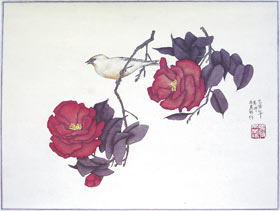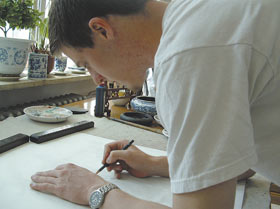  |
| HOME | THIS ISSUE | CALENDAR | GRANTS | BACK ISSUES | < BACK | NEXT > |
Honors student learns to paint in traditional Chinese stylesby Sherry Fisher - December 12, 2005 |
||||
|
The words “gong bi” and “xie yie” didn’t mean much to Matthew Billard before this summer. But now he knows a lot about these styles of traditional Chinese painting and has created 25 works to prove it. Billard, an honors student studying communication design and illustration, spent three weeks in inner Mongolia last summer studying with Liu Baowang, a well- recognized Chinese painter. Liu specializes in large-scale paintings of Mongolian life. “It was a good fit,” says Billard, a senior, who started his academic career in computer science engineering. He already had a connection to China. One of his brothers, a UConn graduate who majored in international business and Chinese, married a Chinese woman and settled there; Liu is his wife’s uncle. “When my brother told me there was an opportunity to study with Liu, I jumped at the chance,” Billard says.
Billard lived with a relative of his sister-in-law, and either walked or bicycled to Liu’s house, where he spent between eight and nine hours a day for three weeks learning the gong bi and xie yie styles. “We knew about 10 words of each other’s language,” Billard says, noting that his brother and other family members acted as translators. “When translators weren’t available, we used gestures.” Billard says Liu had him first trace works in pencil; in this case, they were paintings created by Liu. “Tracing someone’s work might surprise some people,” Billard says, “but in China there isn’t the same sense of copyright or ownership of ideas that we have here. They believe the best way to teach someone is to copy a master’s work. It’s a huge cultural difference.”
After tracing, Billard would copy Liu’s work as he painted his own. A finely detailed gong bi painting of a bird perched on a branch with red flowers took Billard two and a half days to complete. “I used at least 15 to 20 layers of red and six or seven layers of black,” he notes. “It’s very meticulous and detail-oriented. You use brushes, ink, and watercolor. You have to be extremely controlled. You’re using a brush, but you have to get a line that looks like it came from a pen. It’s a very slow process.” Billard says painting in the xie yie style was even more challenging. “Xie yie is very gestural,” he says. “Most of the technique is how you handle the brush. It’s all in the way you move your wrist and hand, how much water you have, what part of the brush you’re using, whether your strokes are fast or slow, wet or dry, or dark or light. Like gong bi, first you work in black and white, then color.” Billard says xie yie “stretched me far more than gong bi. It’s more intuitive and less like an engineer.” In addition to learning about Chinese art, Billard says he learned a great deal about the culture. “They have a great sense of hospitality,” he says. “Family and giving are very important. Mr. Liu was willing to take three weeks out of his life to teach me art, for eight or nine hours a day. That shows a lot about the difference in pace of life in Mongolia as compared to the United States.” Billard says he is still exploring the effects of the trip on his artwork. He hopes to return to China next summer. |
| ADVANCE HOME UCONN HOME |

 The work was supported by a Summer Undergraduate Research Fund grant from the UConn Office of Undergraduate Research.
The work was supported by a Summer Undergraduate Research Fund grant from the UConn Office of Undergraduate Research.
